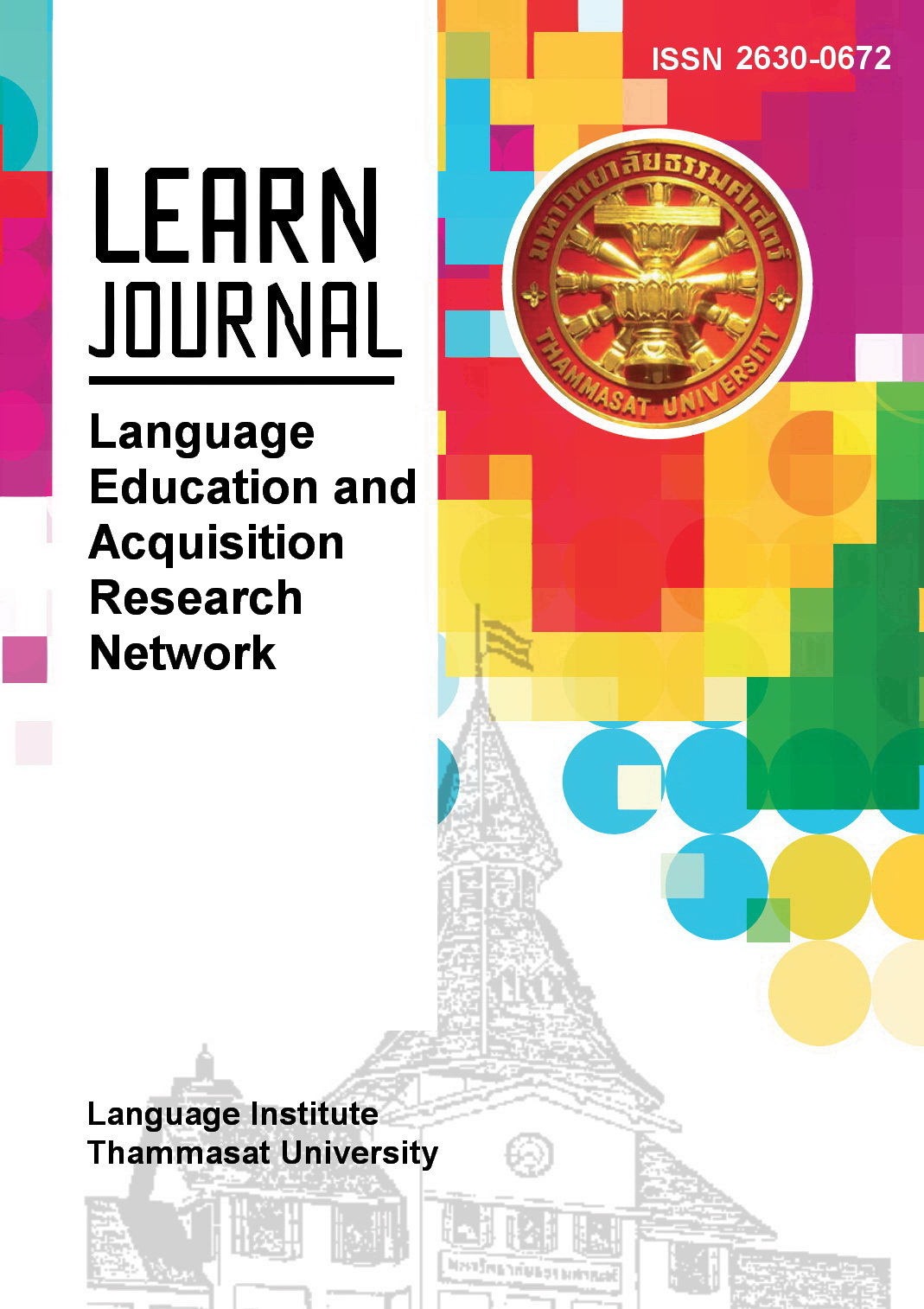Collocation and Discursive Construction of Covid-19 in WHO Director General’s Discourse: A Corpus-based Study
Main Article Content
Abstract
This research investigated the discursive construction of Covid-19 in WHO director general’s discourse through the lens of corpus linguistics and critical discourse analysis. 255 speeches of the WHO director general were collected, forming a 234,149-words corpus. Collocations of ‘Covid-19’ were generated and analyzed in terms of the semantic categories and the representation of Covid-19. The results indicated that Covid-19 was discursively represented as posing severe multifaceted threats to the world. Furthermore, the discursive construction of Covid-19 was found to promote the image of WHO as an active and ethical organization. Thus, discourse was used not only for informational purposes, but it was also manipulated for self-promotion and legitimation.
Article Details
References
Anthony, L. (2020). AntConc (Version 3.5.8) [Computer Software]. Waseda University. Available from http://www.antlab.sci.waseda.ac.jp/
Azamfirei, R. (2020). The 2019 novel coronavirus: A crown jewel of pandemics? The Journal of Critical Care Medicine, 6(1), 3–4.
Baker, P. (2006). Using corpora in discourse analysis. Continuum.
Baker, P., Gabrielatos, C., KhosraviNik, M., Krzyzanowski, M., McEnery, T., & Wodak, R. (2008). A useful methodological synergy? Combining critical discourse analysis and corpus linguistics to examine discourses of refugees and asylum seekers in the UK press. Discourse & Society, 19(3), 273–306. https://doi.org/10.1177/0957926508088962
Barreneche, S. M. (2020). Somebody to blame: On the construction of the other in the context of the Covid-19 outbreak. Society Register, 4(2), 19–32. https://doi.org/10.14746/sr.2020.4.2.02
Cabral, S. (2021, May 21). Covid “hate crimes” against Asian Americans on rise. BBC News. https://www.bbc.com/news/world-us-canada-56218684
Castro Seixas, E. (2021). War metaphors in political communication on Covid-19. Frontiers in Sociology, 5(January), 1–11. https://doi.org/10.3389/fsoc.2020.583680
Center for Disease Control and Prevention. (2021, May 24). Basics of COVID-19. https://www.cdc.gov/coronavirus/2019-ncov/your-health/about-covid-19/basics-covid-19.html
Cooper, S. (2020, April 16). Why is the World Health Organization accused of mishandling the coronavirus pandemic? Global News. https://globalnews.ca/news/6826415/world-health-organization-accused-of-mishandling-coronavirus-pandemic-covid-19/
Fairclough, N. (2003). Analysing discourse: Textual analysis for social science research. Routledge.
Fairclough, N. (2010). Critical discourse analysis: The critical study of language (2nd ed.). Longman.
Fariza, N., Nor, M., & Zulcafli, A. S. (2020). Corpus driven analysis of news reports about Covid-19 in a Malaysian online newspaper. GEMA Online Journal of Language Studies, 20(August), 199–220.
Gramsci, A. (1971). Selections from the prison notebooks (Q. Hoare and G. Nowell Smith Trans.). International Publishers.
Hoey, M. (2005). Lexical priming: A new theory of words. Routledge.
Hoey, M. (2007). Lexical priming and literary creativity. In M. Hoey, M. Mahlberg, M. Stubbs, & W. Teubert (Eds.), Text, discourse and corpora: Theory and analysis (pp. 7–29). Continuum.
Hunston, S. (2002). Corpora in applied linguistics. Cambridge University Press.
Ivic, S. (2021). International organizations and Covid-19 discourse. International Law and Contemporary Framework, 1–8.
Jarvis, L., Anglia, E., & Jarvis, L. E. E. (2021). Covid-19 and the politics of temporality: Constructing credibility. Critical Studies on Security, 9(1), 72–75. https://doi.org/10.1080/21624887.2021.1904363.
Joharry, S. A., Alam, S., Turiman, S., & Alam, S. (2020). Examining Malaysian public letters to editor on COVID-19 pandemic : A corpus-assisted discourse analysis. GEMA Online Journal of Language Studies, 20(3), 242–260.
Liu, M., & Zhang, Y. (2018). Language & Communication Discursive constructions of scientific (Un)certainty about the health risks of China’s air pollution: A corpus-assisted discourse study. Language Sciences, 60, 1–10. https://doi.org/10.1016/j.langcom.2018.01.006
Louw, W. E. (1993). Irony in the text or insincerity in the writer? — The diagnostic potential of semantic prosodies. In M. Baker, G. Francis & E. Tognini-Bonelli (Eds.), Text and technology (p. 157-176). John Benjamins Publishing Company.
McEnery, T., & Hardie, A. (2011). Corpus linguistics: Method, theory and practice. Cambridge University Press.
Nasar, N., Ramzan, A., Tufail, S., Qasim, S., & Hussain, Z. (2020). COVID-19 advertorials accentuating fright and xenophobia in ecosystem: An eco-linguistic approach to SFL. Linguistic Forum, 2(3), 7–14.
Nerlich, B. (2011). The role of metaphor scenarios in disease management discourses: Foot and mouth disease and avian influenza. In S. Handl & H.-J. Schmid (Eds.), Windows to the mind: Metaphor, metonymy and conceptual Blending (pp. 115–142). Mouton de Gruyter.
Nicola, M., Alsafi, Z., Sohrabi, C., Kerwan, A., Al-Jabir, A., Iosifidis, C., Agha, M. & Agha, R. (2020). The socio-economic implications of the coronavirus pandemic (COVID-19): A review. International Journal of Surgery, 78, 185–193. https://doi.org/10.1108/IJSE-12-2018-0651
Olimat, S. N. (2020). Words as powerful weapons: Dysphemism in Trump’s Covid-19 speeches. 3L: Language, Linguistics, Literature, 26(3), 17–29. https://doi.org/10.17576/3L-2020-2603-02
Rosa, A. S. De, & Mannarini, T. (2020). The “invisible other”: Social representations of COVID-19 pandemic in media and institutional discourse. Papers on Social Representations, 29(2), 5.1-5.35.
Scott, M., & Tribble, C. (2006). Textual patterns: Key words and corpus analysis in language education. John Benjamins Publishing Company.
Semino, E. (2021). “Not soldiers but fire-fighters” – metaphors and Covid-19. Health Communication, 36(1), 50–58.
Wodak, R., & Meyer, M. (2009). Critical Discourse Analysis: History, Agenda, Theory and Methodology. In R. Wodak & M. Meyer (Eds.), Methods of critical discourse analysis (pp. 1-31). Sage.
Yang, Y., & Chen, X. (2021). Globalism or nationalism? The paradox of Chinese official discourse in the context of the COVID-19 outbreak. Journal of Chinese Political Science, 26(1), 89–113. https://doi.org/10.1007/s11366-020-09697-1
Yu, H., Lu, H., & Hu, J. (2021). A corpus-based critical discourse analysis of news reports on the COVID-19 pandemic in China and the UK. International Journal of English Linguistics, 11(2), 36. https://doi.org/10.5539/ijel.v11n2p36


